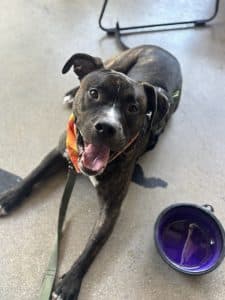
Brewery vibes and good manners — confidence in public starts with calm moments like this.
Taking your dog into public spaces, from cafés and patios to neighborhood walks and local events, can be a fantastic way to build connection and trust. But for many dogs, the outside world can feel unpredictable or even overwhelming. Loud noises, sudden movements, or unfamiliar people and dogs can trigger uncertainty or fear.
Helping your dog feel confident in public places isn’t about forcing them into new situations; it’s about building emotional safety, trust, and predictability. With the right approach, you can transform every outing into a learning experience that strengthens your bond.
Why Confidence Matters for Dogs
Confidence is not about “bravery,” it’s about security. A confident dog trusts that their environment is safe and that their person will guide them through unfamiliar experiences.
When a dog feels safe:
- They recover quickly after startling events.
- They remain curious, not shut down or reactive.
- They look to their human for cues instead of panicking.
Dogs who lack confidence often bark, lunge, freeze, or attempt to flee in public spaces. These behaviors stem from fear or uncertainty, not stubbornness. By helping your dog build confidence through positive, structured experiences, you create a foundation for calm, cooperative behavior everywhere you go.
Scientific studies have shown that dogs trained with positive reinforcement are more likely to exhibit optimism, emotional resilience, and stable behavior than those trained with punishment or aversive tools. Confidence isn’t about exposure alone; it’s about how that exposure happens.
Start Where Your Dog Feels Safe
Confidence starts at home — literally. Your living room, backyard, or quiet street are the ideal “base camp” for confidence training.
Focus on foundation skills:
- Teach a calm “settle” on a mat or blanket.
- Reinforce loose-leash walking in low-distraction areas.
- Use a “focus” cue (“watch me”) to redirect attention from distractions.
- Encourage relaxation near mild noises or moving people from a safe distance.
When your dog succeeds in calm, predictable settings, you’re giving them rehearsals for confidence. These early wins translate directly into more challenging environments later.
Choose the Right Environments
Not all “dog-friendly” places are truly comfortable for dogs. Build up slowly by introducing your dog to low-stress, well-managed environments before taking on busier spaces.
Tips for smart location choices:
- Start small: Try a quiet park or dog-friendly café patio during off-peak hours.
- Bring familiarity: Your dog’s mat, favorite treats, and water bowl help them feel secure.
- Avoid sensory overload: Skip live music, loud events, or crowded sidewalks until your dog’s confidence grows.
- Stay short and sweet: Ten to fifteen minutes of calm exposure beats an hour of overwhelm.
Your goal isn’t to “see how your dog does,” it’s to create success. Every calm, positive outing builds emotional resilience and reinforces trust between you and your dog.
Reading Your Dog’s Body Language
Dogs constantly communicate through body language, and learning to read their signals is key to helping them feel safe in public.
Signs your dog feels confident:
- Soft eyes, relaxed posture, open mouth
- Tail held at a natural height and gently wagging
- Curious sniffing, calm exploration, willingness to engage
Signs of stress or uncertainty:
- Yawning, lip-licking, or excessive panting
- Turning away, crouching, or tail tucked
- Pacing, whining, or pulling to leave
- Ears pinned back, wide eyes (“whale eye”)
If you notice signs of discomfort, take a step back, literally and figuratively. Give your dog space, use calm verbal reassurance, and reward small signs of relaxation.
Confidence doesn’t mean a dog never feels worried; it means they recover quickly because they trust you.
Structured, Supportive Exposure
True confidence isn’t built by “just getting out there more.” It’s developed through thoughtful, step-by-step experiences that set your dog up for success. Each outing should be calm, predictable, and rewarding, the kind of compassionate, structured approach we use every day at Dances With Dogs.
That’s the essence of our training: giving your dog the tools to succeed, not the pressure to perform.
Practice in Real Life: Step-by-Step Confidence Building
Once your dog is comfortable in calm settings, start gently transferring those skills into the real world.
The “3-Step Confidence Builder” Framework:
1. Plan Ahead
Choose a single focus for each outing; for example, relaxing under a table, walking past other dogs, or greeting strangers calmly.
2. Start at a Distance
Don’t jump right into the action. If your dog is nervous about movement or sound, start at a distance that allows them to observe without stress—reward calm, attentive behavior.
3. End on a Win
If your dog stays relaxed and connected for even a few minutes, that’s success! Leave before they get tired or overstimulated.
Gradual exposure and repetition build emotional stability, not flooding or forcing. Every positive experience wires the brain for confidence.
Preparing for Winter or Cooler Weather
Even in Miami, cooler days can surprise both people and pets. When practicing public outings during winter:
- Bring a blanket or mat so your dog isn’t sitting on cold metal or damp ground.
- Offer extra comfort to short-coated breeds, a light coat or sweater can provide added warmth.
- Watch for subtle shivers, tucked tails, or reluctance to lie down, as these are signs your dog is physically uncomfortable.
- Keep outings short, upbeat, and warm, literally and emotionally!
Not Every Dog Wants to Be a Social Butterfly
Here’s something every dog guardian needs to hear:
Not every dog will enjoy crowded patios, loud events, or busy streets, and that’s perfectly okay.
A dog doesn’t need to love chaos to live a full, enriched life. Some prefer quiet trails, shaded benches, or backyard adventures. The goal isn’t to create a “social butterfly,” it’s to help your dog feel safe in the world they enjoy.
Success looks different for every dog:
- For some, confidence means calmly lounging at a café.
- For others, it means quietly sniffing around a quiet park bench.
Both are wins if your dog feels secure and content.
Expert Trainer Tips
Drawing on force-free, science-based training methods, here are key principles we use at Dances With Dogs to build lasting confidence:
- Short, consistent sessions are more effective than marathon outings. Practice a little every week rather than pushing too far in one day.
- Celebrate progress, not perfection. If your dog remained calm for five minutes longer than last time, that’s measurable success.
- Control the environment first. Choose calm spaces where you can manage distance and distractions.
- Watch your own energy. Dogs are sensitive to our emotions. Calm humans help create calm dogs.
- Always end on a positive note. Leave before your dog reaches their threshold. Success builds confidence; stress erodes it.
- Get professional support when needed. A certified force-free trainer can create individualized desensitization and counterconditioning plans for shy, reactive, or anxious dogs.
Beyond Behavior: The Ripple Effect of Confidence
A confident dog is a happy dog, but the benefits go far beyond the behavior itself.
When your dog feels secure in new settings:
- Walks become peaceful and enjoyable, rather than stressful.
- You can include your dog in more family activities.
- Daily mental stimulation increases, leading to improved overall well-being.
- The human-dog bond deepens through shared success.
Confidence transforms everyday life, not just for the dog, but for the people who love them.
Miami’s Dog-Friendly Lifestyle
Miami is filled with dog-friendly patios, parks, and events, from Coconut Grove’s shaded café corners to Midtown’s outdoor brunch spots. But not every outing needs to be an adventure.
Start simple, stay patient, and give your dog choices. Whether it’s a quiet morning stroll or a trainer-guided Drink With Your Dog™ session, the goal is always the same: create positive associations and joyful experiences in public places.
Final Thoughts: Confidence Comes Through Compassion
Helping your dog feel confident in public spaces is one of the greatest gifts you can give them. It requires patience, empathy, and a commitment to understanding their perspective.
When outings are built around trust and safety, your dog learns that the world is not something to fear — it’s something to explore with you.
At Dances With Dogs, we help families in Miami build these skills through force-free, fear-free training that prioritizes emotional well-being. Confidence doesn’t come from exposure alone; it comes from connection, kindness, and consistency.
Learn how we can help you and your dog enjoy calm, confident outings together — visit www.danceswithdogs.com.
